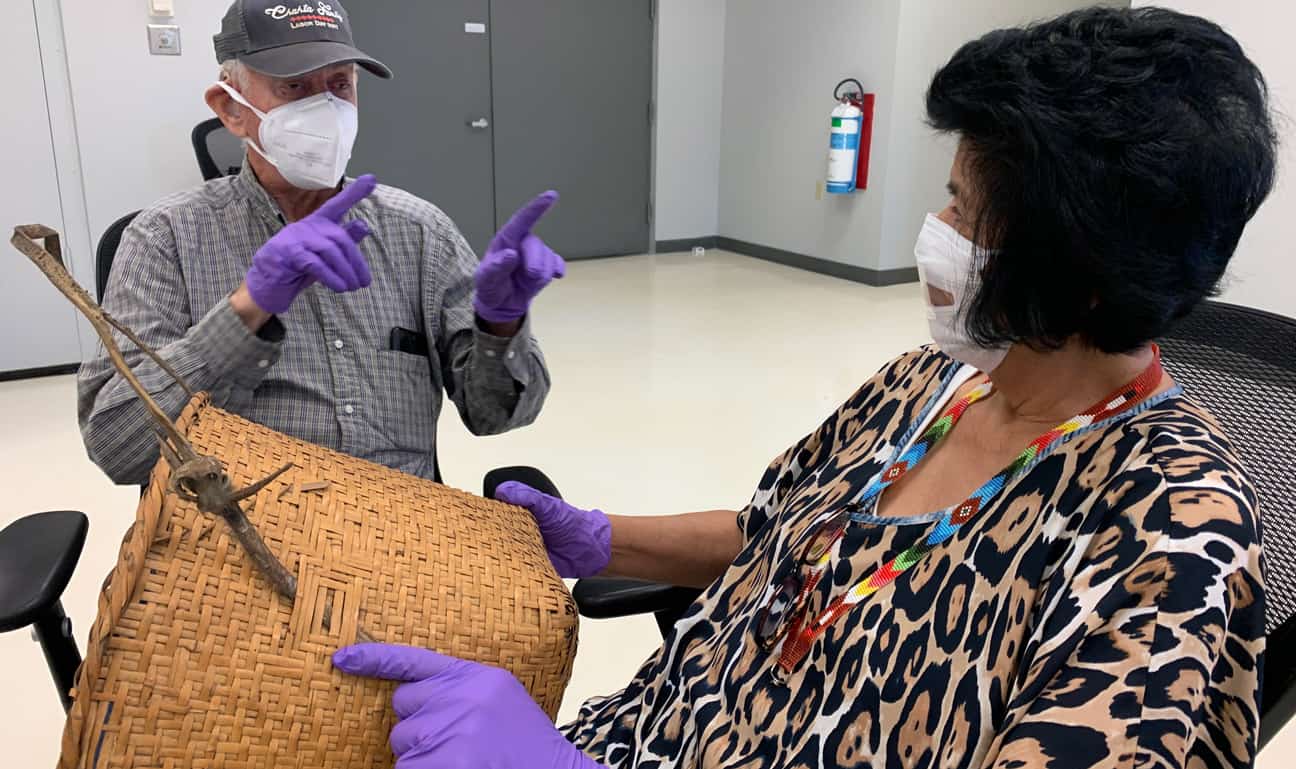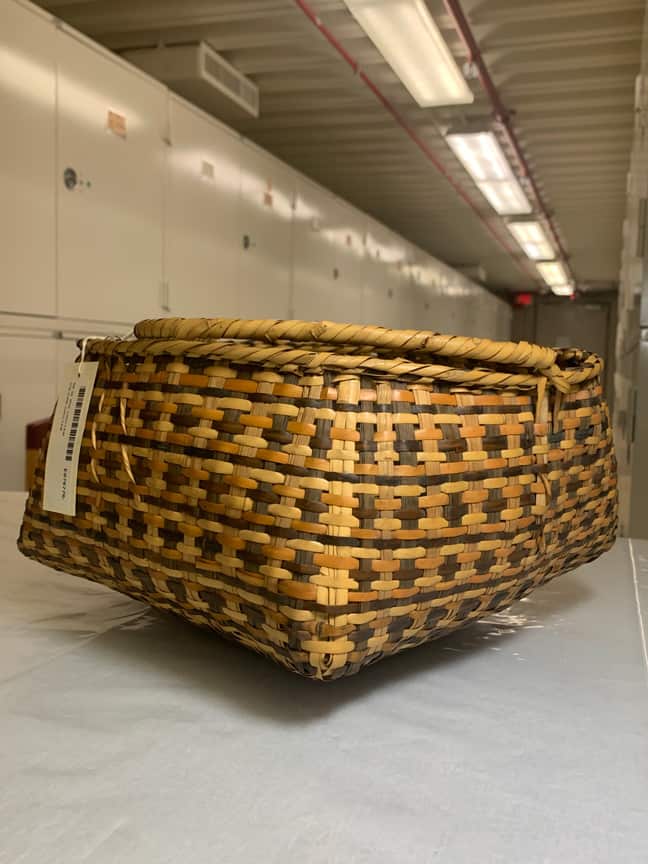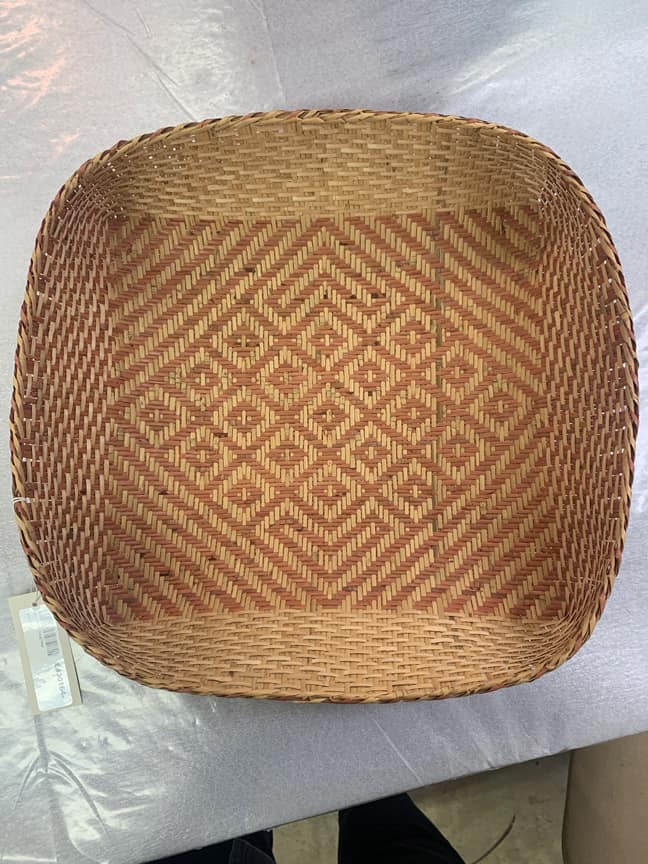
Makers and Masterpieces: Rivercane basketry at the Smithsonian
Iti FabvssaPublished March 1, 2023Over the past few months, Iti Fabvssa has highlighted various traditional arts in the Smithsonian collection and the modern-day Choctaw artists working to carry on these traditions. This month, we conclude our series by discussing rivercane basketry.
Born in a Choctaw community in Louisiana, Fannie Battiest Wesley learned to make rivercane baskets when she was a young girl. She continued to make rivercane baskets after leaving Louisiana and moving to Choctaw territory in the early 1900s. She would harvest and weave the rivercane and find plants like black walnut and sassafras to dye strips of cane to make her designs stand out. Some of the baskets that Fannie made were used around her house. Others, she sold. Collectors like the anthropologist Clark Field, who had one of the largest Native American basket collections, were eager buyers. She taught her daughters and granddaughters the entire process of making rivercane baskets – from harvesting to the completed basket. By the end of Fannie’s life, she had only a few baskets of her own after a lifetime of making rivercane baskets. Years later, one of Fannie’s granddaughters, Eveline Steele, would arrive at the Smithsonian looking for her grandmother’s baskets in hopes of learning from the baskets held in that collection. Currently, Eveline is the only known self-sufficient Choctaw rivercane basket maker in Oklahoma. She has been invaluable in revitalizing and sharing this tradition with the next generation of basket makers.
Another rivercane basket maker is Tom Colvin. Although not Choctaw, Tom grew up learning from two very traditional Choctaw elders in the Bayou Lacomb community of southern Louisiana. They taught him traditional skills for living on the land, how to make traditional Choctaw homes and bird traps, as well as rivercane and palmetto basketry. They passed along their knowledge with the wish that he share it back with the Choctaw community one day. Tom has also learned from other southeastern tribal communities and their basket-making styles, which helps him identify different basket styles. Today, Tom shares what he has learned from his Louisiana Choctaw mentors with other Choctaw communities, including us here in Oklahoma. If you look inside the chukka in the Choctaw Cultural Center, you will find a rivercane mat harvested and woven by Tom. Most recently, he helped the Jena Band of Choctaw Indians build summer homes with palmetto. Our community has been very lucky to have the opportunity to learn from Tom Both he and Eveline have helped tremendously in revitalizing Choctaw arts and better understanding rivercane.
Rivercane has been a part of Choctaw life and landscapes where Choctaw people have lived for hundreds of generations. A tall plant that resembles bamboo and grows near water, rivercane was once found all over the Choctaw homeland and in Southeastern Oklahoma, partly because Choctaw people managed the land to produce healthy river cane stands. Today, it is a difficult plant to find. Fire suppression, over-grazing, and intentional destruction have all made it hard to find rivercane patches with tall enough stalks for baskets. Eveline, who used to visit and gather from the same rivercane patches throughout her childhood with her grandmother, found that they were no longer there later when she was an adult. Those who work with rivercane also know to be frugal with harvesting cane since cane is good for making baskets and is hard to find. If you find rivercane on your property and would like to help with efforts to conserve it, please feel free to reach out to the Historic Preservation department.
When rivercane was everywhere, Choctaw people transformed it into numerous objects for everyday life. It has been used for building homes and made into knives, blowguns, fishing spears, traps, shields, flutes, tongs, pottery tools, traditional foods and (most relevant to our article) baskets. Choctaw people have traditionally made rivercane baskets in many different shapes and sizes. A sample of them can be found in the Smithsonian’s collections, from elbow to bullnose to packback baskets to sifter baskets. There is a wide range of forms from different time periods and geographies.

Pictured is a Choctaw rivercane basket from the Smithsonian collection.

Pictured is a Choctaw rivercane basket from the Smithsonian collection.
Rivercane basket making is not just weaving; it also requires holistic knowledge of the plant and how to process it. Our ancestors fostered healthy patches of river cane on the landscape by regularly setting fire to its growing areas. This removes competing shade and invigorates the cane’s rhizomes for enhanced growth. In a healthy cane patch of the right age, one has to know which stalks to harvest. During an outing to harvest rivercane, Eveline noted that stalks over 18 inches between the nodes are ideal since the nodes make the splitting and weaving more difficult. After the cane is cut, the cane can be washed and split into strips. Working with rivercane is a challenge that takes great care. Even with a lifetime of experience, one can easily cut oneself with a knife while trying to split the rivercane into pliable strips. Rivercane splints are also sharp, so a jagged edge can quickly draw blood. Each stalk of rivercane has to be carefully accessed for the best places to split. It takes patience and skill to make sure that the strips remain long and uniform in size. After being cut into strips, the outer part of the cane has to be peeled off the hard inside. Once that is done, those peeled strips are shaved down to make them bendable. The strips can be dyed in different colors at this point. Upon completing all these steps, one can begin weaving the rivercane into baskets.
In the hands of experienced basket makers like Tom and Eveline, transforming a few shoots of cane into pliable strips ready for weaving can take an afternoon. For an apprentice, the same amount might take them days. Making rivercane baskets requires a good investment in time and commitment to finishing the project. Given this, Tom and Eveline both encourage those interested in rivercane baskets not to give up.
Given the scarcity and difficulty of working with rivercane, commercial reeds have become a popular material for making Choctaw baskets today. Commercial reed can arrive at one’s front porch basically ready for weaving, cutting out all the steps for preparing the rivercane mentioned above. Another one of Fannie Battiest Wesley’s granddaughters who learned from her as well as her mother, Rose Billy, makes her baskets using commercial reed. Commercial reed has been incredibly helpful in making basket weaving more accessible and approachable for many community members. Nevertheless, the knowledge of how to prepare cane for baskets is also very important to pass on to the next generation.
Studying older baskets in museum collections is one way for Eveline and Tom to re-learn old techniques or solutions to problems that they find while making rivercane baskets. Seeing old baskets in person is helpful because they hold knowledge about the possibilities for patterns, shapes and designs. For Eveline Steele, seeing the baskets at the Smithsonian allowed her to compare the natural dyes that we currently use and those used in the past. She stated, “It’s always good to know about dyes but most importantly the ratio and preparation of such dyes. Otherwise, it’s hard to know the many possibilities of dyes, of types and designs of basketry.” She also noted that networking with museum staff and learning from their expertise is invaluable. For Tom, he had traveled with other Louisiana Choctaw basket makers to the Smithsonian to view their baskets back in the 1980s. He recalled that they were only allowed half a day to view the many baskets. While there, he took photos of the baskets that he saw. Since then, he has shared those photos with fellow basket makers and community members whom he has befriended over the years. By sharing his experience back then, many people have been able to learn from that trip even if they did not go themselves. For the 2022 Smithsonian visit, Tom brought a small photo album with pictures of his first visit to share with the museum staff and us. With this second trip, Tom noted that he learned more from the same baskets he saw years ago now that he had gained more experience.
At the Smithsonian’s Museum of Natural History and National Museum of the American Indian, some of the most impressive baskets that are not as common now were the large pack baskets. Tom recalled making some before rivercane became difficult to find; one of his pack baskets is on display in the Cultural Center’s permanent exhibits. He and Eveline studied the museum’s collection intently, taking careful note of the construction and explaining to us why the maker might have made the decisions that they did. Worn on the back, the rivercane pack baskets in that collection incorporate leather straps to wear over the shoulder. Part of the challenge of making a pack basket today is the lack of rivercane large enough to provide support for the bottom.
Working with rivercane basket makers like Tom and Eveline has helped maintain a practice done by generations of Choctaw people. Without the passing of this generational knowledge, this knowledge would have been lost. We hope to learn more about rivercane, how to process it, and how studying older baskets inspires our community to take up the challenge to continue revitalizing this wonderful Choctaw art. If you are interested in learning more about river cane basketry, please click here.

